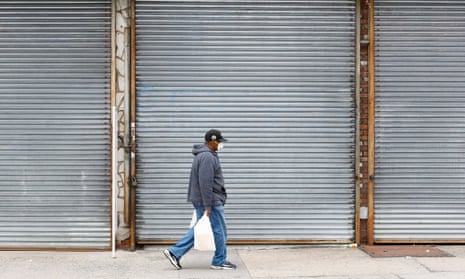The longest economic expansion in US history officially came to an end on Wednesday when the commerce department announced the economy shrank at an annual rate of 4.8% in the first three months of the year.
The economic slump, the steepest since the last recession in 2008, is just an early indicator of how severely the coronavirus pandemic has affected the US economy.
Much of the US economy shut down in March in an effort to contain the virus, triggering 26 million people to file for unemployment benefits and wiping out a decade of jobs gains, at the end of the first quarter. The next set of figures from the commerce department will more accurately reflect the true scale of its impact.
Kevin Hassett, senior economic adviser to the White House, has predicted gross domestic product (GDP) – the widest measure of the economy – could fall at an annualized rate of 30% in the next quarter. Goldman Sachs expects a 15% unemployment rate in the US by mid-year, up from 4.4% at present.
The fall is the sharpest quarterly decline in GDP since the end of 2008 when the economy contracted by an annualized rate of 8.4%. But on current forecasts the drop-off could soon rival the economic collapse of the Great Depression. In 1932 the US economy shrank 13% over the year.
“The US economy is in recession right now,” said Gus Faucher, chief economist at PNC. “We just don’t know how deep.”
Faucher said that while this quarter’s figure looks bad it is nothing to what we can expect next quarter. Most of the shutdowns happened at the tail end of the first three months of the year. PNC is expecting a contraction of about 30% which will be “by far the worst quarter in history”.
But he expects the recovery to start soon after that, and for a strong rebound, if not as dramatic as the fall, once the virus is under control.

The contraction is devastating large parts of the economy and small businesses in particular have been hit hard.
Forbidden Planet, a 30-year-old comics and toys store in Union Square, New York, is one of many businesses that have started money raising online in the hope of keeping their shuttered business alive. The store closed on 16 March but business had trailed off before that as fear of the virus spread through the city.
“There are still a million expenses going out. We are still paying rent,” said Jeff Ayers, the general manager.
Even if the store can weather the pandemic, he said, he worries about what business will look like afterwards. “We are expecting a recession if not a depression. What will that do to sales?” he said.
He said he also worries that limiting occupancy at the store in compliance with social distancing orders will kill a business largely built on volume and people’s ability to browse. “Nothing is going to be the same for a very long time,’’ he said.
